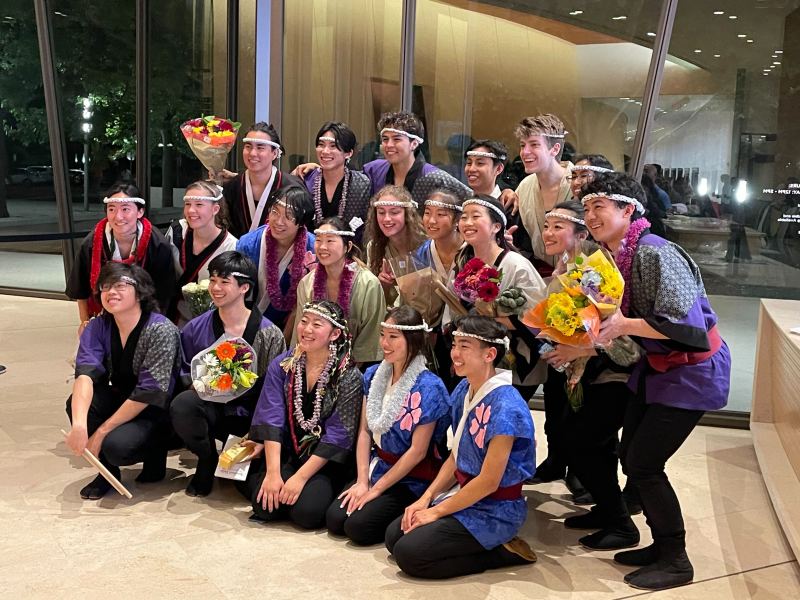Welcome back from intermission! We will now begin the second half of our concert.
“Clockwork”
Complexity of song content with simplicity in terms of players and setup is what “Clockwork” brings to the table. Staging and movement throughout the song really amplifies the impact of the playing and gives viewers the impression that the performers are indeed gears within a clock. The song took some inspiration from one of the song captain’s previous works years ago, and seeing how much had changed since then added so much color to the song and gives me hope that I too will find my unique style of playing — performing — taiko.
Transition — “Hachijo”
Here, the “Hachijo Daiko” song is rearranged to showcase another style of playing. Even with minimal equipment (one chu on a high upright stand) and personnel, the two performers were able to fill the concert hall with the sound of the drum and their voices blending in harmony. It was not the volume of their performance that captured attention; rather, it was their presence and ability to command the stage with the small amount of equipment, not in spite of it.
“Two Heavens as One”
Two disparate, constantly warring parts of the self internally and externally are able to unite and come together and unite as one. Played in hachijo style and with longer bachi to better emulate Miyamoto Musashi’s two-sword style, this song combined several different styles to create a more technically challenging piece that made it all the more satisfying when I finally played it correctly and on time.
At times, “Two Heavens” felt like the representation of my struggles with taiko; there were days when it felt like I was fighting a battle with myself to truly show up and be the best version of myself by not letting the negative self-talk impact my performance. It’s only through understanding myself better and finding that sense of balance within that I have been able to be more balanced on the outside and be more present when I play during practice and then perform on stage. That internal negative self-talk will continue to be here, and forcing it down and pretending it doesn’t exist are not going to erase the fact that it’s very much there; it took accepting that I have fear and patiently working to channel that nervous energy into focusing that I have been able to play better and be more present.
Transition — “Arashi No Mae”
A classic piece that we use as transitions during gigs, “Arashi” expresses the false sense of calm before the storm unfolds, the feeling I had leading up to the week before concert. The storm of pre-concert stress wasn’t as chaotic as I had expected. Just like the storm in “Arashi” isn’t portrayed as something gloomy or dull but is instead something with excitement and joy as reflected in the performers’ faces and body language and ki-ais from those watching, the pre-concert stress I was so worried about was changed into a sense of excitement, having alleviated by fellow members as they gave me advice and also reminded me to relax. They helped me channel those nerves into excitement, something I did during the transition right before playing the odaiko (the largest drum) in our finale. We were in it together after all, working together to produce a great show — and that we did.
“Hanabi Taikai”
To close out our concert with a new take on a core rep piece, this arrangement of “Hanabi Taikai” not only has ensemble members in a circle facing outwards to take advantage of Bing’s circular nature and address as much of the audience as possible, but also has, among rearrangements of existing parts, a new part, katsugi okedo, drums that can be played slung over one’s shoulder, written in so that the whole of Stanford Taiko can, as an ensemble, close out our Spring Concert — together. It’s one of the rare times that everyone in our ensemble is playing a song at the same time, and it’s special for everyone, whether it’s their first or last time playing all together with our full ensemble on the big stage, as the beginning or end of an era. It’s fitting that this finale to our concert, the culmination of months of practice and prepwork during and outside of official practice times, is about the joy experienced during festivals as you watch the fireworks at night with your loved ones, marveling at their bright colors and enjoying each other’s company. It’s the joy on our faces and in our movements as we perform, it’s the joy in the audience clapping along to the beat, it’s the joy as performers and audience share smiles during bows and those after-performance selfies mingled with sweaty hugs and exclamations of pride, the “good job!”s and the “you did so well oh my gosh!”s.
Here’s to Jam!-ming out with chu all for the years to come!
